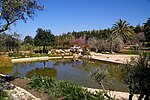The Tel Aviv–Jerusalem railway (also higher-speed railway to Jerusalem, Plan A1, and Railway 29) is a railway line in Israel connecting the cities of Tel Aviv and Jerusalem. The line serves as the main rail link between the two cities, complementing the old Jaffa–Jerusalem railway. As such, the railway is often referred to in Israel as the high-speed railway to Jerusalem to distinguish it from the older, longer and slower line. In spite of that name, the line is not high-speed under the definition used by the International Union of Railways: both its design speed of 200 km/h (125 mph) and its current operational speed of 160 km/h (99 mph) are below the 250 km/h (155 mph) threshold used by the UIC to define high-speed railways, and it is traversed by IR's regular rolling stock instead of the UIC requirement for specially-designed high-speed trains.The newly constructed railway section to Jerusalem branches off from the Tel Aviv–Lod railway at the Ganot Interchange southeast of Tel Aviv and spans about 56 km (35 mi) of electrified double track. It cost approximately NIS 7 billion (about US$2 billion in 2008 dollars) – due to the extensive bridging and tunneling required along the mountainous route. Besides the construction of the new railway section, the existing railway from Herzliya to Ganot Interchange underwent electrification. The railway's design speed is 160 km/h (99 mph) with a projected non-stop travel time of approximately 28 minutes from Tel Aviv HaHagana railway station to Jerusalem–Yitzhak Navon railway station. As of 2019, the scheduled travel time between Ben Gurion Airport railway station and Jerusalem is 22–26 minutes, and between Tel Aviv HaHagana and Jerusalem 32–34 minutes (including the stop at Ben Gurion Airport). This compared with about 75 minutes each way using the Jaffa–Jerusalem railway from Tel Aviv HaHagana to southern Jerusalem's Malha station, which unlike Jerusalem–Navon, is located relatively far from the city center.
Construction of the railway began in 2001. It was the first heavy rail line in Israel to be electrified and was originally planned to open in 2008, but various objections, bureaucratic delays and engineering difficulties caused planning and construction to span over two decades, with the line opening for service in stages. The first section, between the Ganot interchange on Highway 1 and Ben Gurion Airport opened in October 2004 and made train travel possible between Tel Aviv and the airport. Another section completed in 2007 is used by trains operating between central Israel and Modi'in. The final section opened on 25 September 2018 and enabled service between Jerusalem–Navon and Ben Gurion Airport. As electrification works progressed northwards from the airport through Tel Aviv to Herzliya, service to and from Jerusalem was extended to include additional stations, beginning with Tel Aviv HaHagana on 21 December 2019, Tel Aviv HaShalom and Savidor Central on 30 June 2020, and Tel Aviv University and Herzliya on 21 September 2020. With the completion of electrification works to Binyamina in February 2023, nighttime-only service was extended from Hertzliya to Netanya, Hadera West And Binyamina. A railway spur which opened on 31 March 2022 also enables direct service on the line between Jerusalem and Modi'in.
Eventually, trains from Jerusalem are expected to continue all the way to northern Israel as future phases of Israel Railways' electrification project are carried out along the Coastal Railway, with the long-term plan of trains originating from Jerusalem terminating at Karmiel by the mid 2020s.












